GTPases are a large family of hydrolase enzymes that bind to the nucleotide guanosine triphosphate (GTP) and hydrolyze it to guanosine diphosphate (GDP). The GTP binding and hydrolysis takes place in the highly conserved P-loop "G domain", a protein domain common to many GTPases.
Small GTPases, also known as small G-proteins, are a family of hydrolase enzymes that can bind and hydrolyze guanosine triphosphate (GTP). They are a type of G-protein found in the cytosol that are homologous to the alpha subunit of heterotrimeric G-proteins, but unlike the alpha subunit of G proteins, a small GTPase can function independently as a hydrolase enzyme to bind to and hydrolyze a guanosine triphosphate (GTP) to form guanosine diphosphate (GDP). The best-known members are the Ras GTPases and hence they are sometimes called Ras subfamily GTPases.
The Coat Protein Complex II, or COPII, is a group of proteins that facilitate the formation of vesicles to transport proteins from the endoplasmic reticulum to the Golgi apparatus or endoplasmic-reticulum–Golgi intermediate compartment. This process is termed anterograde transport, in contrast to the retrograde transport associated with the COPI complex. COPII is assembled in two parts: first an inner layer of Sar1, Sec23, and Sec24 forms; then the inner coat is surrounded by an outer lattice of Sec13 and Sec31.
The Rab family of proteins is a member of the Ras superfamily of small G proteins. Approximately 70 types of Rabs have now been identified in humans. Rab proteins generally possess a GTPase fold, which consists of a six-stranded beta sheet which is flanked by five alpha helices. Rab GTPases regulate many steps of membrane trafficking, including vesicle formation, vesicle movement along actin and tubulin networks, and membrane fusion. These processes make up the route through which cell surface proteins are trafficked from the Golgi to the plasma membrane and are recycled. Surface protein recycling returns proteins to the surface whose function involves carrying another protein or substance inside the cell, such as the transferrin receptor, or serves as a means of regulating the number of a certain type of protein molecules on the surface.
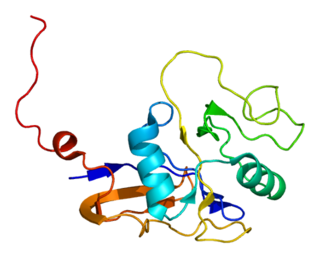
GTPase HRas, from "Harvey Rat sarcoma virus", also known as transforming protein p21 is an enzyme that in humans is encoded by the HRAS gene. The HRAS gene is located on the short (p) arm of chromosome 11 at position 15.5, from base pair 522,241 to base pair 525,549. HRas is a small G protein in the Ras subfamily of the Ras superfamily of small GTPases. Once bound to Guanosine triphosphate, H-Ras will activate a Raf kinase like c-Raf, the next step in the MAPK/ERK pathway.
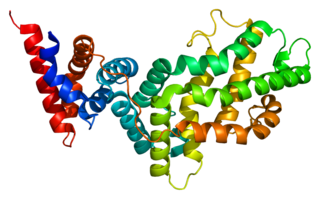
RAS p21 protein activator 1 or RasGAP, also known as RASA1, is a 120-kDa cytosolic human protein that provides two principal activities:
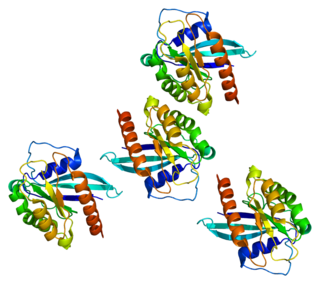
Ras-related protein Rab-7a is a protein that in humans is encoded by the RAB7A gene.

Ras-related protein Rab-6A is a protein that in humans is encoded by the RAB6A gene located in the eleventh chromosome. Its main function is the regulation of protein transport from the Golgi complex to the endoplasmic reticulum and the exocytosis along with the microtubules.

Rab GDP dissociation inhibitor alpha is a protein that in humans is encoded by the GDI1 gene.
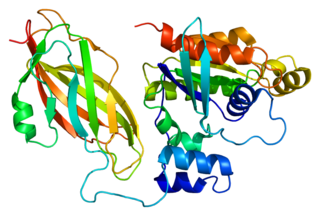
Rac2 is a small signaling G protein, and is a member of the Rac subfamily of the family Rho family of GTPases. It is encoded by the gene RAC2.

Ras-related protein Rap-2a is a protein that in humans is encoded by the RAP2A gene. RAP2A is a member of the Ras-related protein family.

Ras-related protein Rab-1A is a protein that in humans is encoded by the RAB1A gene.
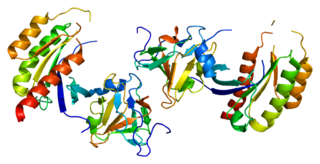
Ras-related protein Rab-8A is a protein that in humans is encoded by the RAB8A gene.

Ras-related protein Rab-1B is a protein that in humans is encoded by the RAB1B gene.

Ras-related protein Rab-2A is a protein that in humans is encoded by the RAB2A gene.
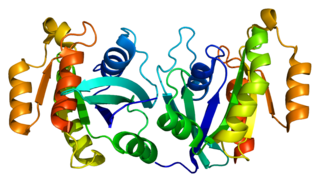
Ras-related protein Rab-11B is a protein that in humans is encoded by the RAB11B gene. Rab11b is reported as most abundantly expressed in brain, heart and testes.

Ras-related protein Rab-33A is a protein that in humans is encoded by the RAB33A gene.

Ras-related protein Rab-8B is a protein that in humans is encoded by the RAB8B gene.

Ras-related GTP-binding protein B is a protein that in humans is encoded by the RRAGB gene.

Ras and EF-hand domain-containing protein also known as Ras-related protein Rab-45 is a protein that in humans is encoded by the RASEF gene.





















